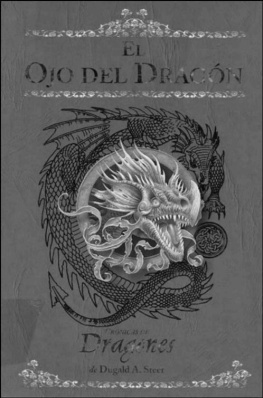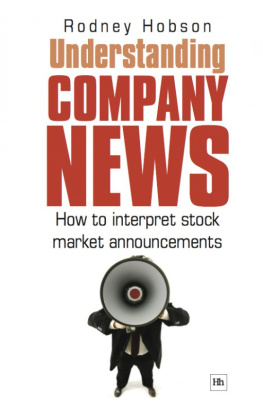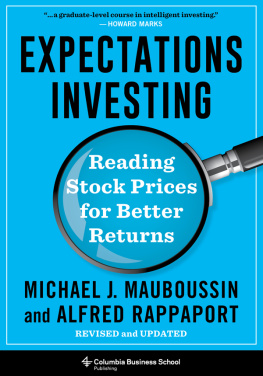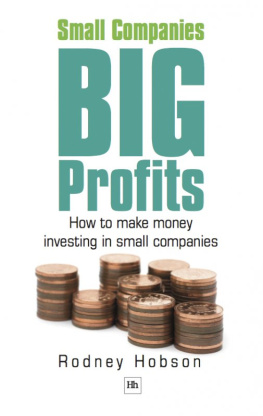THE SIGNS
WERE THERE
THE SIGNS
WERE THERE
THE CLUES FOR INVESTORS THAT
A COMPANY IS HEADING FOR A FALL
TIM STEER

First published in Great Britain in 2018 by
Profile Books Ltd
3 Holford Yard
Bevin Way
London
WC1X 9HD
www.profilebooks.com
Copyright Tim Steer, 2018
Designed and typeset by
The moral right of the author has been asserted.
All rights reserved. Without limiting the rights under copyright reserved above, no part of this publication may be reproduced, stored or introduced into a retrieval system, or transmitted, in any form or by any means (electronic, mechanical, photocopying, recording or otherwise), without the prior written permission of both the copyright owner and the publisher of this book.
A CIP catalogue record for this book is available from the British Library.
ISBN 9781788160803
eISBN 9781782834625
For Andrea and Thomas
Contents
Introduction
The high cliff divers of Acapulco
PART 1 Abracadabra
How profits can be maximised by turning costs into assets
PART 2 Stock matters
How profits can be affected by stock value
PART 3 Promises and estimates
The difficulties with accruals
PART 4 Not so good
When goodwill goes bad
PART 5 Busy building less value
The acquisition addiction
PART 6 Never mind the width, feel the quality
Deteriorating assets
PART 7 Crunch
There is no ignoring bad debts
PART 8 Too cosy for comfort
Related party transactions
PART 9 Beware of conflict
When auditors get too close for comfort
PART 10 The trend is your friend
Financial analysis and the use of ratios
Conclusion
Diving lessons
Acknowledgements
This book is written for the many who invest on their own account or for others, but it celebrates the few who recognise the significance and importance of a companys financial statements. Of all the people I know, those who count among the few are listed below and include those who have been an inspiration to me. All have enquiring minds and have sought answers to difficult questions. Many have done the right thing in difficult circumstances and in some cases at a cost to themselves. On behalf of all investors I would like to thank them for their vigilance.
Adrian Frost
Adrian Gosden
Alan Brierley
Alan Miller
Alistair Currie
Alistair Osborne
Andrew Jackson
Andy Bamford
Andy Brough
Angus Cockburn
Ashton Bradbury
Barney Randle
Bruce Davidson
Charles Lambert
Chris Bamberry
Daud Khan
David Bamber
David Hellier
David Toms
Derek Stuart
Emma Mercer
Eric Tracey
Euan Lovett-Turner
Evie Bowyer
Frank Field
Frank Manduca
Gavin James
Gavin Oram
George Godber
George Luckcraft
Gerald Khoo
Harald Hendrikse
Harry Nimmo
Henry Dixon
Howard Seymour
Howard Shilit
Iain Dey
Jacob de Tusch-Lec
James Quinn
Joe Brent
John Collingridge
John Waples
Jon Lewis
Judy Groves
Katharine Wynne
Kean Marden
Keith Cochrane
Kevin Ashton
Leo Quinn
Louise Armitstead
Mal Patel
Margaret Young
Mark Tyndall
Martin Green
Martin Hughes
Mary Hardy
Matthew Earle
Matthew Groves
Max Dolding
Michael Donnelly
Mike Geering
Mike Unsworth
Miles Costello
Natasha Landell-Mills
Neil Blackley
Neil Hermon
Neil Roberts
Nigel Ridge
Nigel Thomas
Oliver Shah
Paul Morland
Peter Davies
Peter Dickinson
Peter Smedley
Phil Bentley
Phil Oakley
Quintin Price
Richard Dale
Richard Findlater
Richard Fletcher
Richard King
Richard Leonard
Richard Plackett
Roger Hardman
Rosemary Banyard
Rupert Soames
Ruth Keattch
Simon Cawkwell
Sir David Tweedie
Stephen Liechti
Stephen Yiu
Terry Smith
Tim Good
Wes McCoy
Will Lewis
William Tamworth

Introduction
THE HIGH CLIFF DIVERS OF ACAPULCO
Company share price disasters are like the plunges made by the famous high cliff divers of Acapulco. This is because the 135-feet dives that these brave men make from the cliffs of La Quebrada into the shallow waters below resemble what the share prices of companies do when they go spectacularly wrong. However, among the high cliff divers of Acapulco, there has never been a casualty, whereas a precipitous drop or even a more drawn out extended swallow dive in a companys share price may well result in it going bust, with shareholders, employees, suppliers, bankers, auditors and now, increasingly, even regulators caught by the shock waves. Some companies do of course recover, often with new management at the helm, but even then the fall-out for shareholders and other stakeholders following the share price collapse can be severe.
For all the companies featured in this book, the dives in the share prices and the company disasters that resulted in bankruptcy could have been predicted by little more than a browse through the annual reports or prospectuses if you knew where to look. But it seems that many of the great and the good in the world of investing do not bother to look at these important documents, and blame the auditors and increasingly the regulators when things go wrong. But the warning signs are regularly there, in the form of accounting shenanigans or other clear signs that a business is changing direction for the worse, or that excellent results are being reported only because of one-off and non-recurring items. Often these red flags are either not seen or are ignored by investors and other stakeholders.
The collapse in January 2018 of Carillion, which had received enormous amounts of public money as one of the UK governments favourite construction and support services companies, is just one in a long line of corporate disasters where even a cursory look at the balance sheet by anyone with a smattering of financial training would have evoked a feeling of dj vu and the realisation that the company was heading for a fall. Of course, not all share price disasters can be predicted by reading the annual report of a company, but it is a start and, with a little bit of knowledge, issues can be identified and a potentially loss-making decision avoided. This book is aimed at helping investors see the signs that there may be trouble ahead.
When looking at annual reports, always consider the Iceberg Principle. An annual report should be seen as an iceberg in terms of the information it contains. It cannot tell you all you need to know about a company, but if there is something in it that makes you feel uneasy, there may well be other even more uncomfortable things lying below the metaphorical water line. And that is often reason enough to sell the shares if you have a holding in the company, or to avoid it if you have not.
This book contains twenty-two stories about companies that suffered dramatic falls in their share prices. Some survived the fall, some did not. But in the cases of twenty of these companies there were clear signs in their annual reports that all was not well, and in the initial public offering (IPO) prospectuses of the other two companies, there were items that should have raised a quizzical eyebrow or two among potential investors. Although around half of the companies featured in this book got to grips with their problems and survived, thanks to the efforts and strategy of new management, the others did not.
Next page






